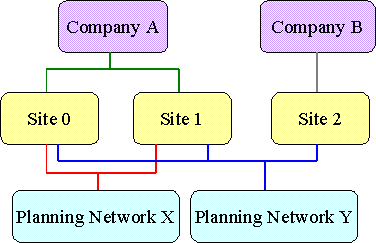
Planning across multiple sites is important when companies have multiple sites in different locations. The multi-site feature is used for various planning activities in IFS applications. Presently, the site concept is used for both execution and planning. Planning across multiple sites necessitates that the multiple sites are treated as one entity during the planning process, for example, during the Material Requirements Panning (MRP). This is achieved by creating a Planning Network.
The planning network defines which sites will be planned together by the multi-site planning systems. However, it does not define a sequence of planning or any sort of precedence between sites. Some of the features of a planning network are:
The network could cover a number of sites from different companies that should be planned as one unit. A potential scenario is shown in the example below.

In this case there are two companies involved: Company A and Company B. Company A has 2 sites (A1, A2), and Company B also has 2 sites (B1, B2). Site B2 is planned as a single site, as presently possible in IFS Applications (Network II). The other three sites (A1, A2, B1) are viewed as one unit using a network consisting of three sites (Network I). The implication of this is that for execution of customer orders, purchase orders, and shop orders, sites are dealt with individually. For planning, e.g., to set due dates for orders and to evaluate capacity, a wider scope is used since the three sites are considered as one entity, i.e., Network I.
It is also possible to have a site in more than one planning network. For example, company A has 2 sites (0 and 1), and company B has one site (2). Network X can be set up to plan the Company A sites (0 and 1), and Network Y can be setup to plan all the sites in the internal supply chain (0, 1, 2). (See the example below).

Planning systems will be able to plan for all the sites in a network, and thereby improve the overall coordination between sites.